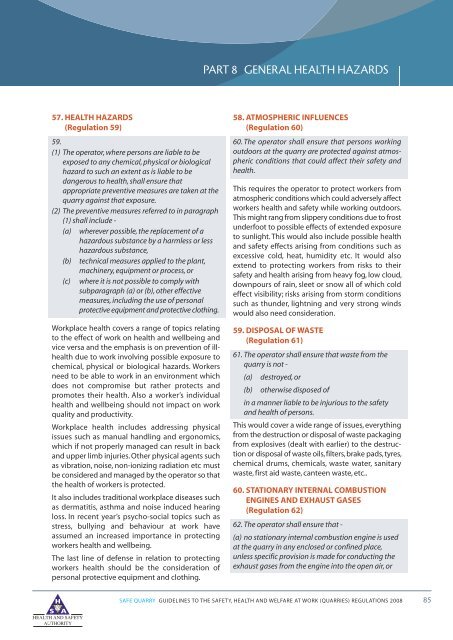Safe Quarry - Health and Safety Authority
Safe Quarry - Health and Safety Authority
Safe Quarry - Health and Safety Authority
You also want an ePaper? Increase the reach of your titles
YUMPU automatically turns print PDFs into web optimized ePapers that Google loves.
PART 8 GENERAL HEALTH HAZARDS<br />
57. HEALTH HAZARDS<br />
(Regulation 59)<br />
59.<br />
(1) The operator, where persons are liable to be<br />
exposed to any chemical, physical or biological<br />
hazard to such an extent as is liable to be<br />
dangerous to health, shall ensure that<br />
appropriate preventive measures are taken at the<br />
quarry against that exposure.<br />
(2) The preventive measures referred to in paragraph<br />
(1) shall include -<br />
(a) wherever possible, the replacement of a<br />
hazardous substance by a harmless or less<br />
hazardous substance,<br />
(b) technical measures applied to the plant,<br />
machinery, equipment or process, or<br />
(c) where it is not possible to comply with<br />
subparagraph (a) or (b), other effective<br />
measures, including the use of personal<br />
protective equipment <strong>and</strong> protective clothing.<br />
Workplace health covers a range of topics relating<br />
to the effect of work on health <strong>and</strong> wellbeing <strong>and</strong><br />
vice versa <strong>and</strong> the emphasis is on prevention of illhealth<br />
due to work involving possible exposure to<br />
chemical, physical or biological hazards. Workers<br />
need to be able to work in an environment which<br />
does not compromise but rather protects <strong>and</strong><br />
promotes their health. Also a worker’s individual<br />
health <strong>and</strong> wellbeing should not impact on work<br />
quality <strong>and</strong> productivity.<br />
Workplace health includes addressing physical<br />
issues such as manual h<strong>and</strong>ling <strong>and</strong> ergonomics,<br />
which if not properly managed can result in back<br />
<strong>and</strong> upper limb injuries. Other physical agents such<br />
as vibration, noise, non-ionizing radiation etc must<br />
be considered <strong>and</strong> managed by the operator so that<br />
the health of workers is protected.<br />
It also includes traditional workplace diseases such<br />
as dermatitis, asthma <strong>and</strong> noise induced hearing<br />
loss. In recent year’s psycho-social topics such as<br />
stress, bullying <strong>and</strong> behaviour at work have<br />
assumed an increased importance in protecting<br />
workers health <strong>and</strong> wellbeing.<br />
The last line of defense in relation to protecting<br />
workers health should be the consideration of<br />
personal protective equipment <strong>and</strong> clothing.<br />
58. ATMOSPHERIC INFLUENCES<br />
(Regulation 60)<br />
60. The operator shall ensure that persons working<br />
outdoors at the quarry are protected against atmospheric<br />
conditions that could affect their safety <strong>and</strong><br />
health.<br />
This requires the operator to protect workers from<br />
atmospheric conditions which could adversely affect<br />
workers health <strong>and</strong> safety while working outdoors.<br />
This might rang from slippery conditions due to frost<br />
underfoot to possible effects of extended exposure<br />
to sunlight. This would also include possible health<br />
<strong>and</strong> safety effects arising from conditions such as<br />
excessive cold, heat, humidity etc. It would also<br />
extend to protecting workers from risks to their<br />
safety <strong>and</strong> health arising from heavy fog, low cloud,<br />
downpours of rain, sleet or snow all of which cold<br />
effect visibility; risks arising from storm conditions<br />
such as thunder, lightning <strong>and</strong> very strong winds<br />
would also need consideration.<br />
59. DISPOSAL OF WASTE<br />
(Regulation 61)<br />
61. The operator shall ensure that waste from the<br />
quarry is not -<br />
(a) destroyed, or<br />
(b) otherwise disposed of<br />
in a manner liable to be injurious to the safety<br />
<strong>and</strong> health of persons.<br />
This would cover a wide range of issues, everything<br />
from the destruction or disposal of waste packaging<br />
from explosives (dealt with earlier) to the destruction<br />
or disposal of waste oils,filters,brake pads,tyres,<br />
chemical drums, chemicals, waste water, sanitary<br />
waste, first aid waste, canteen waste, etc..<br />
60. STATIONARY INTERNAL COMBUSTION<br />
ENGINES AND EXHAUST GASES<br />
(Regulation 62)<br />
62. The operator shall ensure that -<br />
(a) no stationary internal combustion engine is used<br />
at the quarry in any enclosed or confined place,<br />
unless specific provision is made for conducting the<br />
exhaust gases from the engine into the open air, or<br />
SAFE QUARRY GUIDELINES TO THE SAFETY, HEALTH AND WELFARE AT WORK (QUARRIES) REGULATIONS 2008 85
















